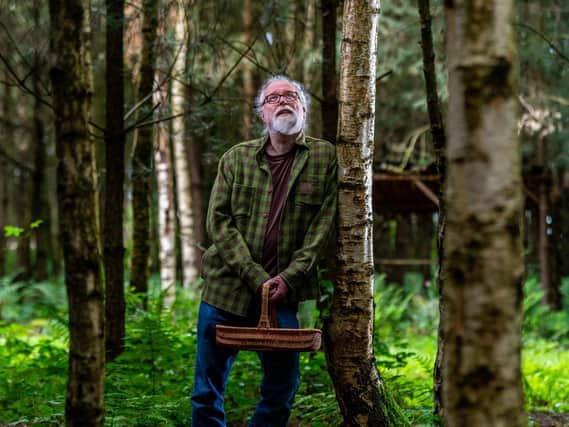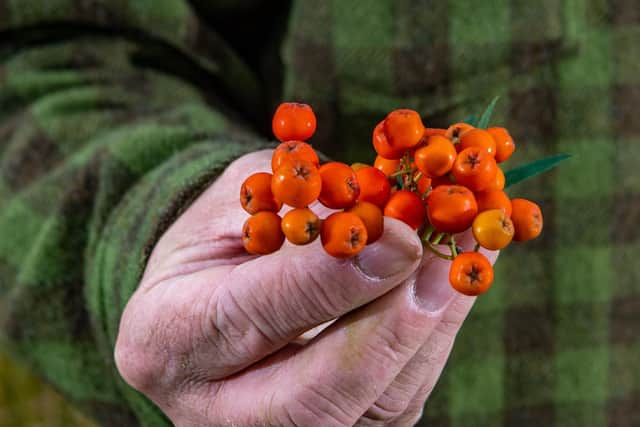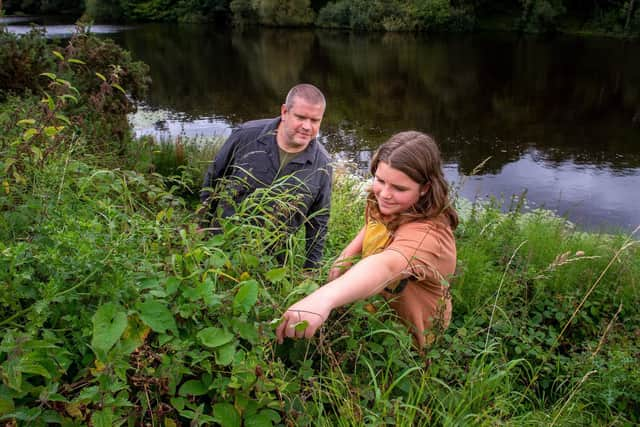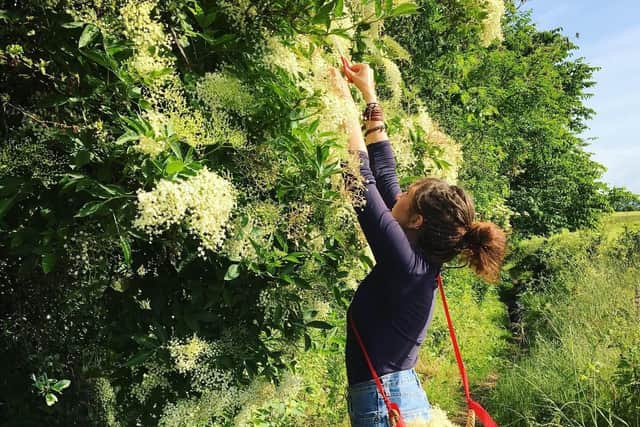Meet the foragers encouaging us to make the most of nature's larder


“I found myself picking an edible plant out of a wall next to a bus stop once and eating it – no one would sit next to me on the bus,” he jokes.
While his fellow passengers might have thought his behaviour somewhat strange, Chris was simply putting into practice what he’s learned through years of foraging for food; a hobby that’s transformed his understanding of how the natural environment can enrich our store cupboards and diets.
Advertisement
Hide AdAdvertisement
Hide AdSince the days of our ancient hunter-gatherer ancestors, we – at least in the western world – have slowly lost touch with our instincts when it comes to the edible outdoors.


Yet somehow, in the age of the 24-hour supermarket and next-day delivery, thousands are returning to this ancient practice, even if through decidedly non-ancient avenues: the most popular Facebook group for UK-based foragers has racked up more than 31,000 members and counting.
“Interest just keeps on growing and growing,” says Chris, who has run his Taste the Wild foraging courses with his partner Rose for 15 years. The teaching takes place largely in Yorkshire, which Chris estimates is home to “over 300 [wild] ingredients” in the form of plants and fungi.
During lockdown, when the fragilities of our food supply system were laid bare, a spike in Google searches for “wild garlic” over late March and April suggest that droves of people set out to forage in their local area – some for the very first time.
Advertisement
Hide AdAdvertisement
Hide AdThough Chris acknowledges that lockdown gifted many with spare time to go out foraging, he says the demographic of those seeking his courses has been slowly broadening for years.


“Way back [when we first started] it was very much country people and prepping, survivalist types who were interested... but then our business started to change and we got more foodie people who actually want to use the things they’ve foraged in higher end cooking.
“We’ve had enthusiastic and inspiring seven-year-olds, we’ve had octogenarians and older who are rediscovering things that they learned when they were kids.”
Though it may seem a pointless exercise to some, given the relative convenience of a supermarket, foragers insist that the practice is about much more than the material gains.
Advertisement
Hide AdAdvertisement
Hide Ad“It’s the whole thing... just going out in the woods and walking through them, it takes your mind off things,” says Martin Milner, a retired police officer who regularly forages with his daughter near their home in East Morton while running a Facebook group for local foragers.


Rachelle Martyn, who lives in the Yorkshire Dales, found this dimension of foraging particularly soothing during lockdown, when so much in the world was uncertain.
“At the beginning of lockdown I saw some leaves which I thought might be wild strawberries, so every week I did that walk to see if they were, and about a month in I found out I was correct... it was nice because it was just a constant [during lockdown] to check on how it was growing.”
Part of her interest in foraging, she says, also stems from a desire for self-sufficiency. Though Rachelle holds no delusions that she could survive on foraging alone, her ability to conjure up exciting dishes from ingredients she’s harvested herself is a source of comfort: when she couldn’t get hold of honey during lockdown, she made some herself with dandelions plucked from a spot close to home.
Advertisement
Hide AdAdvertisement
Hide Ad“We’re really lucky in Yorkshire”, she adds, “because we’ve got rivers, we’ve got woodland, we’ve got open pasture, we’ve got the coast... we’ve got so much stuff to forage.”
While Chris believes he and his partner Rose could “just about survive” a summer on foraging “and a little hunting” alone, he stresses that foraging is less about survival, more about “supplementing your food and making it more interesting with ingredients that you can’t go out to the shop and buy.”
It’s a sentiment demonstrated on Martin’s foraging Facebook group, which is bursting with recipes listing all manner of weird and wonderful plant-based ingredients: salads garnished with Japanese knotweed chutney; wild garlic and mustard root mash; elderflower fritters with garden gooseberry coulis.
Though the natural world has an abundance of edible plants and fungi freely available to anyone seeking them out, Chris warns that caution is paramount when it comes to foraging. “Never eat anything that you can’t absolutely, positively identify... that’s one of the key messages in our courses.”
Advertisement
Hide AdAdvertisement
Hide AdThe second key message, says Chris, is the sustainable element of foraging “teaching people to be careful when they pick plants.”
In the past, Chris has been accused of “teaching the middle classes how to plunder the countryside”; a point of view that he strongly disagrees with. “One of the biggest problems a lot of nature charities have is truly engaging people about what nature is... that’s what foraging makes you understand... the more you know about something, the more you value it, the more you protect it”.
He adds, too, that foraging gives people a better understanding of seasonality, as well as making them less wasteful. “If you go and buy a bag of salad you’ll maybe leave that in the back of the fridge to go soggy, and it’ll be in the bin before you’ve used it.
“Whereas if you’ve had to go out and source it yourself, you start to realise how long things take to produce. I can almost guarantee that you’re not going to let it sit at the back of the fridge.”
Advertisement
Hide AdAdvertisement
Hide AdIt’s a shift in perception Chris witnesses on his courses, with attendees who are initially surprised by the small surface area covered on the day – “some expect they’re going on a 10-mile hike” – beginning to “look where they tread every time they put their foot down” by the afternoon.
There’s an eagerness in some, he says, to dive headfirst into foraging and expect to reap huge amounts as a beginner – something which misses the point entirely. “In the modern world, we think everything should be quite fast tracked. Yes, it’s exciting but you can’t just go out next week and do it unless you’re with somebody experienced... the more you invest in something the more it will give back.”
It’s this slow process, in fact, which makes foraging enjoyable in Rachelle’s eyes – as there’s always something new to be learned.
“I would really recommend a course to start,” she says, adding that, after starting with “obvious things like berries” she built up her confidence and knowledge, and now feels comfortable identifying dozens of wild ingredients – and using them to make her own home-brewed wine.
Advertisement
Hide AdAdvertisement
Hide AdThough the countryside, naturally, has more opportunities for foraging, Chris is adamant that those living in urban areas can reap the benefits, too.
“Someone from The Telegraph once wrote to me and said ‘I live in Clapham Common. What chance have I got (with foraging)?’... We found 29 wild edibles in view of his balcony in East London.”
It’s common, says Martin, for newcomers to believe that they have to travel far away from their local area to find edible plants and fungi, failing to realise the abundance of what’s available right on their doorstep.
But instead of trying to seek out specific things and becoming disheartened or frustrated in the process, he says, the best route for beginners is to look at what’s actually in front of them.
Advertisement
Hide AdAdvertisement
Hide Ad“Rather than going out and looking for something specific, start in your garden, your local area, your local park, find a plant or mushroom and try to identify that... there’s so many edibles out there that you might not expect.”
Support The Yorkshire Post and become a subscriber today.
Your subscription will help us to continue to bring quality news to the people of Yorkshire. In return, you'll see fewer ads on site, get free access to our app and receive exclusive members-only offers.
So, please - if you can - pay for our work. Just £5 per month is the starting point. If you think that which we are trying to achieve is worth more, you can pay us what you think we are worth. By doing so, you will be investing in something that is becoming increasingly rare. Independent journalism that cares less about right and left and more about right and wrong. Journalism you can trust.
Thank you
James Mitchinson